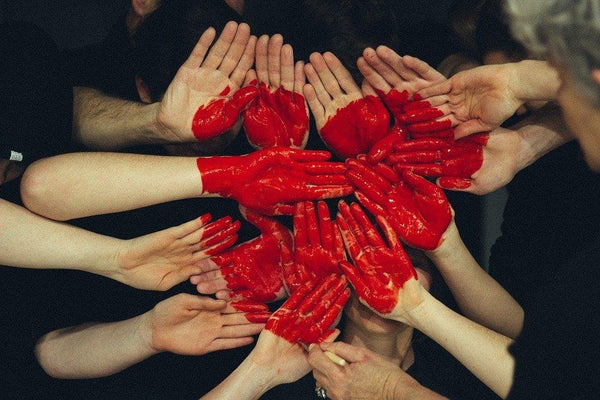Abstract Art Movements & How They Shaped Modern Abstract Art 📰

While different art forms have become pretty common now, hanging artwork was previously only reserved for the elite. Earlier paintings were meant to be concrete depictions of reality and it took a long time for artists to adopt an abstract style of painting. It wasn’t until the early 20th century that many artists started veering away from the concept of realism in the art to a more modern form of painting that consisting of lines, shapes, and swirls. Read on as we look at what abstract art really is, how it came to be recognized as a proper art form, and more.
What is Abstract Art?
Abstract art is identified by different names all over the world. It may be referred to as non-objective art, geometric abstraction, and so on. Some art critics have gone as far as to say that all art counts as abstract because even when artists are making realistic paintings, they are using their perception and their subjective view while they put color on the canvas. This is where art lovers have created the artistic scale of abstraction where what we know as abstract art falls on the extreme right and other works labeled as realistic become semi-abstract.
What is the Premise of Abstract Art?
Think of it this way: a work of art, no matter how crude or basic it is will still catch your gaze and interest you if the colors are appealing and pop out of the canvas. Abstract art focuses heavily on the use of color to depict its true meaning.
Building onto this, the human mind holds a fascination for the unknown, so while a realistic painting such as a still life may be appreciated for its technique and skill, it won’t be as memorable and as engaging over time, as a series of lines, shapes, and symmetry (or asymmetry) that can have a different meaning and appearance every time.
Some abstract artists have gone as far as to say that the work they create is the equivalent of a piece of composed music that speaks for itself without being questioned.
The History of Abstract Art

The origins of abstract art can be found in the Stone Age, where prehistoric rock engravings displayed geometric patterns. Thereafter, cave paintings in many different eras and places such as Mexico showed more abstract engravings to the point where they became the major art form overshadowing the concept of realism.
However, in developed civilizations, realism was still the preferred art form. The major demand was for artwork that was a depiction of reality and it wasn’t until the late 19th century that abstraction was starting gaining societal acceptance. The early 1900s saw the development of new colors and shapes in the art world.
Movements into Abstraction
Abstract art, as it is recognized today, underwent a number of transformations since its inception in the 19th century.
The Impressionist Movement
The Impressionist Movement took place around 1870 – 1890 and while the art was definitely not realistic, the concept was still heavily embedded in creating depictions of the real world. Artificial pigments were manufactured to create vibrant colors with the idea of giving paintings a luminous effect. The focus during this time was to paint outdoor scenes such as landscapes, seascapes, outdoor cafes, and so on. The painting style primarily consisted of rough and obvious brush strokes.
Perhaps the most famous piece of this time is Claude Monet’s Water Lilies where short, vertical, and horizontal strokes were used along with luminous green paint to capture the lilies under the bridge.
The Expressionist Movement
The Expressionism Movement was dominant during the early 1900s and was characterized by the works of world-renowned painters like Van Gogh and James Ensor. This was also the time during which one of the founders of abstractionism, Wassily Kandinsky, published a book on abstract art with the focus on the fact that colors in particular along with shapes and lines have high emotional value. Since he himself had synaesthesia (the ability to hear color), he greatly believed that art is recognized by that part of the brain that interprets sounds and rhythm.
The Expressionist Movement particularly included a number of German artists and their use of bright colors inspired many others to follow suit. It must be noted that Kandinsky placed great importance on the use of color, showing depth, and not just being a superficial perception.
During this same time period, France had the Fauvism movement that had similar undertones in the painting style.
The Cubism Movement
The early 1900s also saw the introduction of cubism which was a direct contrast to the soft, mellow painting style of the impressionist movement. During this time, iconic artists like Picasso (whose work is considered to be semi-abstract) and others became prominent. While ancient artwork had always relied on a three-dimensional aspect to make paintings appear more lifelike, the cubists believed in creating their work on a two-dimensional platform and displaying different angles of the same focal piece to, at a distance, make it appear to be lifelike. Even then, the focus was on creating an alternate depiction of reality.
The cubist movement inspired artists across Europe to create their own unique art forms such as the futurism movement in Italy, where the focus was on kinetic art.
Tubism was another spin-off of cubist art where the cubist framework was applied to using cylindrical and round shapes to create similar overlapping artworks. The movement was led by Fernand Leger.
Kandinsky also became the inspiration for artists all over the world and inspired the Suprematism movement in Russia with the idea of featuring bright colors on white backgrounds.
The Avant-Garde Art Movement
This Dutch movement took place around the late 1800s to early 1900s and was centered on geometric patterns. The founder of this movement, Doesburg, relied on creating artwork that consisted of black and white grids combined only with primary colors.
The Surrealist Movement & Abstract Expressionism
As the different forms of abstract art began to grow, the focus shifted from stringent lines and geometric patterns to something a little more relaxed and free-flowing. The movement started out in Europe and with many of its founders migrating towards the United States, it spread across the globe. The efforts of these artists paid off with the creation of the Museum of Modern Art in 1929, followed by the Museum of Non-Objective Painting in 1939, or as we now know it, the Guggenheim.
With the advent of the Second World War and the Great Depression, abstract art became quite erratic with no particular pattern or style. Icons such as Pollock and Rothko found different ways to express themselves and adopted vastly different painting styles, many of them incorporating the anxiety and stress of the time they were living in.
As such, the abstract expressionism form of creating art still holds different meanings for different art lovers. The term combines an art form that focuses on color more than shape and the lack of geometry and symmetry. The main goal of this art form is to depict raw human emotion. The idea is to find out what people feel when they look at the artwork as opposed to what they see in it.
This was the time when there was no one particular style followed by abstract artists and the different techniques of abstract painting began to grow. They encompassed drip and pour techniques, obvious brush strokes, and more.
The Art Informel Movement
In the 1940s, Europe saw an abstract art movement known as Art Informel. The movement encapsulated a range of new techniques such as using paint dabs and splotches, avant-garde painting styles, etc.
The Op-Art Movement
Led by Bridget Riley and Victor Vasarely, the op-art movement brought back geometric abstraction but took it to the next level by creating monochrome artworks that tricked the naked eye into believing that there were multiple colors present due to the geometric patterns used. This movement somewhat died down towards the latter half of the 1900s.
Postmodernist Abstract Art
The postmodernism form of art was based on the belief that individual interpretation and experiences held more substance than commonly accepted principles and instead of focusing on one simplistic answer, it focused on skepticism and questioning everything. Postmodernist artists refused to accept one single acceptable art form and took over what we now know as the sense of artistic freedom. This was perhaps the time when art finally descended from the elite class to be open to all.
Abstract Art Styles
Abstract art today is still quite similar to the postmodern art movement of accepting all different painting styles and art forms. However, abstract art movements over the centuries have highlighted some abstract art types that are still popular today:
Curvilinear Style

This form of art features swirls, spirals, and other patterns using curved lines, and any form of straight lines and perpendiculars is non-existent here. These swirls are inspired by the human face involving curved symmetry between the different facial features.
Geometric Abstraction
A stark contrast to the curvilinear style, geometric abstraction is based heavily on straight lines and geometric shapes like triangles, squares, and so on. With no ties in concrete realism, this art form is considered to be the highest level of abstraction.
Emotional Abstract Art
The colors and shapes used in this form of art tend to emulate those found in nature. This art form was adopted by many great artists, including Rothko, whose work invokes such powerful emotions that viewers even now are moved to tears.
Light-Related Abstract Art
This form of art relies on using colors that have a luminescent quality and includes the works of the Monet, Kandinsky, and more.
Gestural Abstract Art
This form of abstract art focuses more on the technique of art, including alternate brush strokes, drip painting, and other creative ways of putting color on a canvas.
Minimalist Abstract Art
This avant-garde style of artwork relies on clean lines and monochrome and solid colors.
Abstract Art Today

Art movements throughout history have shaped abstract art as we know it today, and while different eras focused in different art forms, the current form of abstract art is based on using whichever technique the artist finds appealing. The modern form of abstraction covers brush techniques, drip painting, splotches, digital prints, and more in all sorts of colors, including solid to gradient color schemes and more.
Abstract art has been used historically as a form of individual expression and to show the world view of the artists, and today, this has been taken to the next level. Abstract art has proven to have mental health benefits where the audience can find hidden meanings in the artwork that are actually a reflection of their own thoughts and emotions.
Abstract art today is hung in homes, in hospitals, and displayed in galleries to show each artist’s unique style. The print on canvas encompasses everything from straight to curved lines, geometric to free-flowing shapes, bright colors to black and white prints, and more.
Even today, many artists still hold onto the belief that all art is abstract and merely falls on a spectrum of work that is a semi to completely abstract depending on how deeply rooted the work is in realism and concrete truths.












